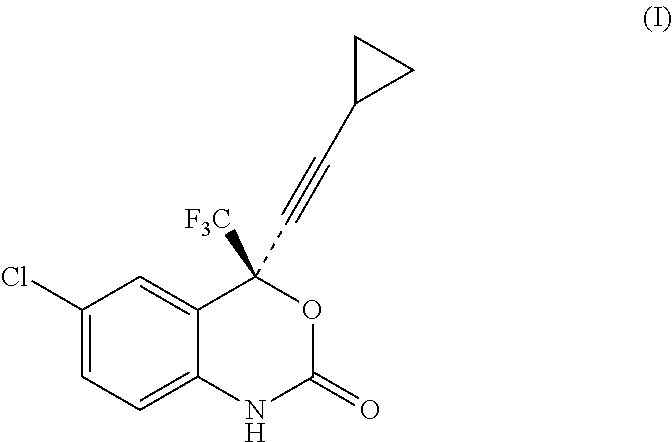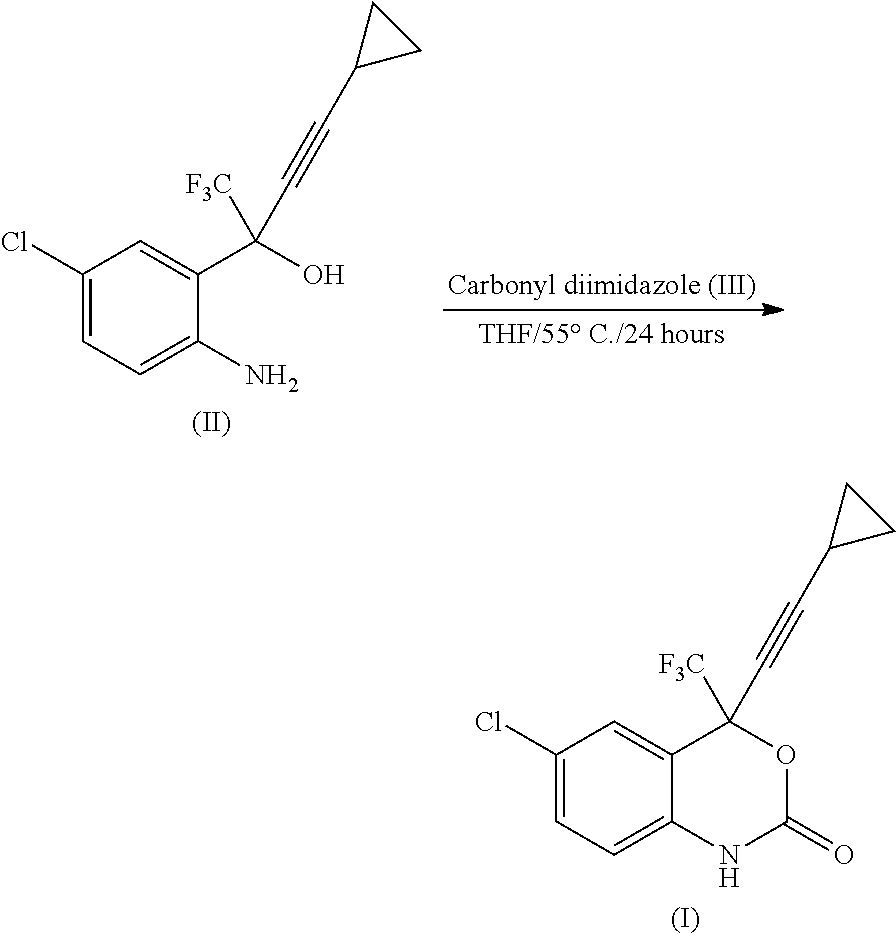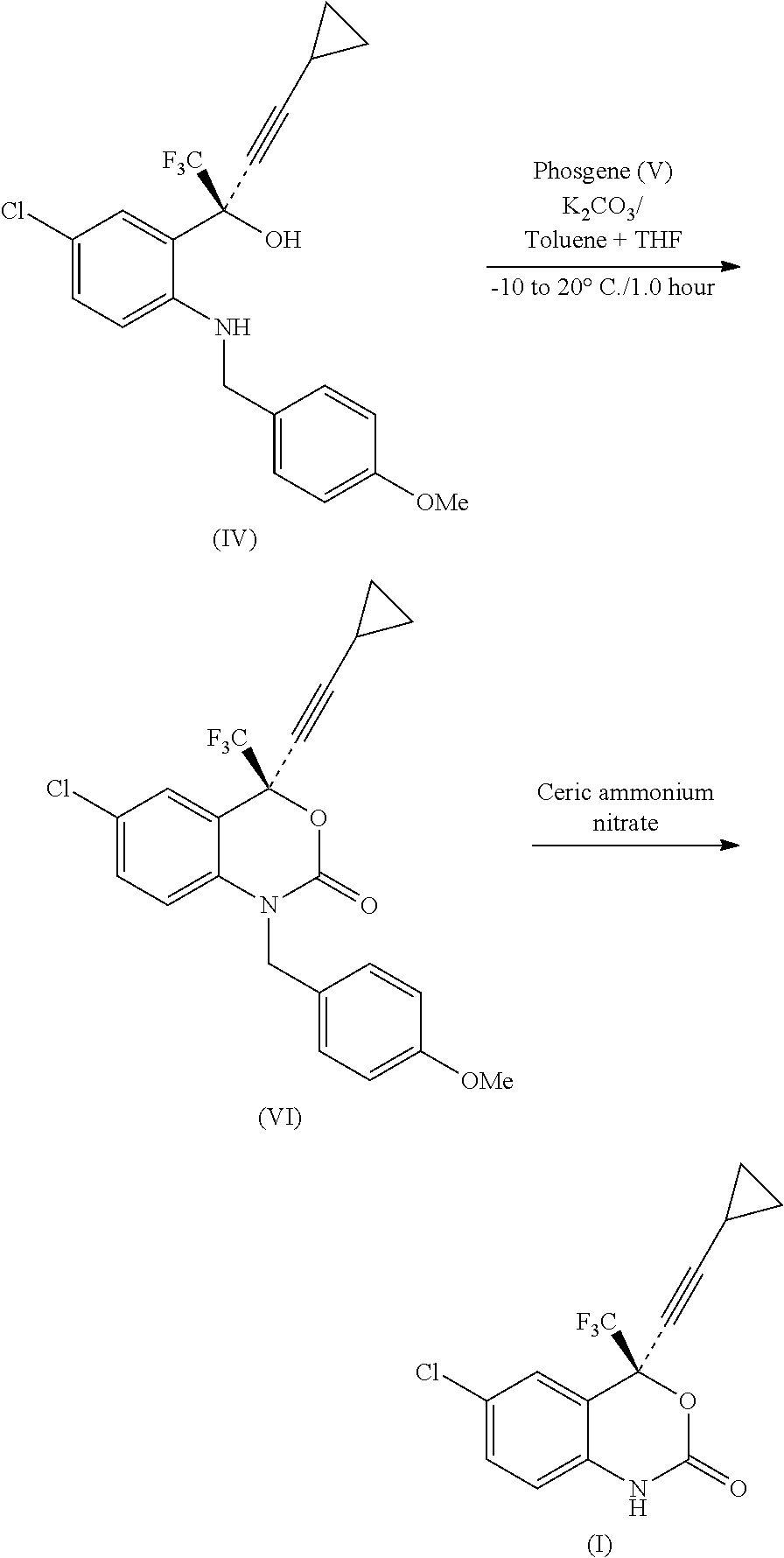Process for the preparation of efavirenz
a technology of reverse transcriptase inhibitor and process, applied in the field of process for the preparation of efavirenz, to achieve the effect of simple, efficient and cost-effectiv
- Summary
- Abstract
- Description
- Claims
- Application Information
AI Technical Summary
Benefits of technology
Problems solved by technology
Method used
Image
Examples
example 1
[0081](S)-5-Chloro-α-(cyclopropylethynyl)-2-amino-α-(trifluoromethyl) benzene methanol (100 gms; 0.345 moles) was added to acetonitrile (100 ml) in a 1000 ml flask, under continuous purging of nitrogen. Sodium bicarbonate (42.30 gms) dissolved in water (200 ml) was added to the flask at 25 to 30° C. and the mixture was cooled to −10° C. Triphosgene was dissolved in acetonitrile (50 gms; 0.168 moles in 200 ml of acetonitrile) was added to the reaction mixture between −10 and −5° C. The reaction mixture was stirred for 1 hour at −10 to −5° C. and was further stirred at 20-25° C. till completion of reaction as monitored by HPLC. The reaction mixture was optionally neutralized with dilute sodium carbonate solution. Water (150 ml) was gradually added to the reaction mixture at room temperature. The mixture was cooled to 10° C. to 15° C. and filtered. The wet cake was washed with DM water (400 ml) and dried under vacuum.
Yield: 106 gms.
% Yield: 97.25.
Purity: 99.72%.
example 2
[0082](S)-5-Chloro-α-(cyclopropylethynyl)-2-amino-α-(trifluoromethyl) benzene methanol (10 gms; 0.034 moles) was added to acetone (10 ml) in a 250 ml flask, with nitrogen purging. Sodium bicarbonate (4.3 gms; 0.05 moles) dissolved in water (20 ml) was added to the flask at 25 to 30° C. and the mixture was cooled to −10° C. Triphosgene dissolved in acetone (5 gms; 0.016 moles in 20 ml of acetone) and was added to the reaction mixture between −10 and −5° C. The reaction mixture was stirred for 1 hour at −10 to −5° C. and further, stirred at 20-25° C. till completion of reaction as monitored by HPLC. The reaction mixture was neutralized with sodium bicarbonate solution. Reaction mixture was filtered through 0.2 micron filter and was washed with 5 ml Acetone. Water (80 ml) was then gradually added to the reaction mixture at room temperature. The mixture was cooled to 10° C. to 15° C., and the product of formula (I) was filtered. The wet cake was washed with DM water (40 ml) and dried un...
example 3
[0084](S)-5-Chloro-α-(cyclopropylethynyl)-2-amino-α-(trifluoromethyl) benzene methanol (5 gms; 0.017 moles) was added to tetrahydrofuran (5 ml) in a 250 ml flask, under continuous purging of nitrogen. Sodium bicarbonate (2.11 gms; 0.025 moles) dissolved in water (10 ml) was added to the flask at 25 to 30° C. and the mixture was cooled to −10° C. Triphosgene was dissolved in tetrahydrofuran (2.5 gms; 0.008 moles in 10 ml of Tetrahydrofuran) and added to the reaction mixture between −10 and −5° C. The reaction mixture was stirred for 1 hour at −10 to −5° C. and further, stirred at 20-25° C. till completion of reaction as monitored by HPLC. The reaction mixture was neutralized with dilute sodium bicarbonate solution. Reaction mixture was filtered through 0.2 micron filter and was washed with 2.5 ml tetrahydrofuran. Water (65 ml) was gradually added to the reaction mixture at room temperature. The mixture was cooled to 0° C. to 5° C., and filtered. The wet cake was washed with DM water ...
PUM
| Property | Measurement | Unit |
|---|---|---|
| temperature | aaaaa | aaaaa |
| temperature | aaaaa | aaaaa |
| organic | aaaaa | aaaaa |
Abstract
Description
Claims
Application Information
 Login to View More
Login to View More - R&D
- Intellectual Property
- Life Sciences
- Materials
- Tech Scout
- Unparalleled Data Quality
- Higher Quality Content
- 60% Fewer Hallucinations
Browse by: Latest US Patents, China's latest patents, Technical Efficacy Thesaurus, Application Domain, Technology Topic, Popular Technical Reports.
© 2025 PatSnap. All rights reserved.Legal|Privacy policy|Modern Slavery Act Transparency Statement|Sitemap|About US| Contact US: help@patsnap.com



